|
|

HNA Summary Report
The Importance
of Scale in Large River Ecosystems
|
|
Depending on their mobility and life requirements, the scale or geographic
extent of habitats is important to river organisms. Aquatic and floodplain
species in the UMRS have adapted to the size of river habitats and the
dynamic set of river habitat conditions for millennia. The major landforms
of the present UMRS developed over 11,000 years ago during the retreat
of glaciers. The north-south orientation of the Mississippi River provided
refuge for species during glacial times and continues to provide a corridor
for migration and dispersal of many life forms.
|
|
Basin and Continental Scales
The basin and larger scales are appropriate when considering the habitat
needs of animals that migrate over long distances. Among fish, paddlefish,
sturgeon, skipjack herring, and the American eel are notable long distance
migrants. Many bird species migrate between North, Central, and South
America. Although many species migrate beyond the UMRS, they all require
specific habitat resources when they use areas along the rivers.
|
1.Place
the cursor over the image at lower left for a preview of the individual
reaches.
2.Click within the image at lower left for a detailed view of the
land cover/use for each reach. |
|
|
|
|
|
System Scale
The UMRS, as defined by EMP authorizing legislation, includes the Upper
Mississippi River from Minneapolis, Minnesota to Cairo, Illinois, the
entire Illinois River, and navigable portions of the Minnesota, St. Croix,
Black, and Kaskaskia Rivers. This HNA covers the aquatic and floodplain
areas of the UMRS.
|
|
River Reach Scale
Twelve river reaches (see image above) have been defined according
to the dominant geomorphic features of the Mississippi and Illinois
Rivers. These geomorphic features provide the template upon which
plant communities and animal habitats developed. The geomorphic
features (see sidebar) of a river reach also influence the river’s
response to impoundment for navigation. The shallow reservoirs,
or navigation pools, in some river reaches developed broad, open-water
impounded areas, whereas others show little apparent plan form (see
sidebar below) change due to impoundment. Habitats and the ecological
communities they support differ among river reaches, thus resource
opportunities, problems, and management differ among the river reaches.
|
|
Geomorphology is the geological study of the configuration
and evolution of land forms. Fluvial geomorphology is the
study of the development of land forms, streams, and rivers
under processes associated with running water. Plan form is
the shape of a landscape as seen from above, or in map view.
The GIS maps used throughout this report are plan form views
of habitat. Plan form images from different time periods are
used to measure change in the river system.
|
|
|
|
|
|
Lake sturgeon and other fish species may
migrate hundreds of miles among river reaches.
|
|
Some species migrate over a regional scale to complete their life
cycle. Regional migratory fish include species such as walleye,
smallmouth bass, white bass, and some sucker species that move upstream
to spawn, often in tributaries to the mainstem rivers. Dams and
tributary habitat degradation have reduced access to habitat for
these fishes. Many bird species migrate along the Mississippi River
to find warmer winter temperatures in southern states.
|
|
|
Navigation Pool Scale
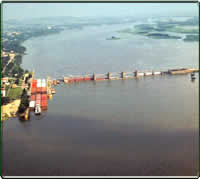 The
mainstem dams of the UMRS navigation project formed a series of shallow
reservoirs called navigation pools. The pool scale is important in assessing
the physical environment that defines habitat for species that display
seasonal movements of about 20 miles or less. UMRS navigation pools differ
in their mix of habitats among river reaches. Wide-ranging residents within
navigation pools include a variety of fishes such as largemouth bass,
northern pike, catfish, and buffalo which make seasonal movements to find
appropriate habitats to spawn, feed, or over-winter. Some species require
flooded vegetation to spawn, others need structure and undercut banks,
and some require firm bottom substrate. Most fish species require winter
habitat with low current, adequate levels of dissolved oxygen, and water
temperatures higher than freezing. All seasonal habitat needs for resident
species The
mainstem dams of the UMRS navigation project formed a series of shallow
reservoirs called navigation pools. The pool scale is important in assessing
the physical environment that defines habitat for species that display
seasonal movements of about 20 miles or less. UMRS navigation pools differ
in their mix of habitats among river reaches. Wide-ranging residents within
navigation pools include a variety of fishes such as largemouth bass,
northern pike, catfish, and buffalo which make seasonal movements to find
appropriate habitats to spawn, feed, or over-winter. Some species require
flooded vegetation to spawn, others need structure and undercut banks,
and some require firm bottom substrate. Most fish species require winter
habitat with low current, adequate levels of dissolved oxygen, and water
temperatures higher than freezing. All seasonal habitat needs for resident
species 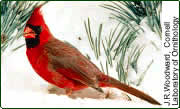 must
be met within a navigation pool because dams restrict access to other
navigation pools. Resident birds maintain home ranges over many square
miles. Cardinals, blue jays, woodpeckers, crows, and many others may use
both floodplain and upland habitats. Some bird species may nest in one
floodplain habitat and feed in another which requires that important habitats
are available within their home range. must
be met within a navigation pool because dams restrict access to other
navigation pools. Resident birds maintain home ranges over many square
miles. Cardinals, blue jays, woodpeckers, crows, and many others may use
both floodplain and upland habitats. Some bird species may nest in one
floodplain habitat and feed in another which requires that important habitats
are available within their home range.
|
|
Habitat Scale
The habitat scale is the level that is actually occupied by organisms.
UMRS habitats must provide suitable resources to meet the needs
of a variety of riverine organisms. Habitats for long-distance migrants
and wide-ranging species are large, while relatively immobile organisms
such as freshwater mussels have small habitat areas. Most riverine
organisms have habitat needs that can be measured in square yards
to tens of acres. Many river organisms require diverse habitat conditions,
with multiple habitat types in close proximity. Most river processes
act at the habitat scale and protection and restoration is generally
focused at this scale.
|
|
|
| Crappie, bluegills, and many minnows may live their entire
life in one backwater lake. |
|
|
|
Many animal species have small home ranges that meet all their life history
needs. Even migratory species will use small home ranges within their
seasonal habitats. For species with system-wide distribution it is important
that critical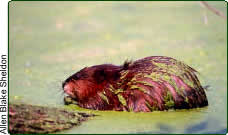 habitats are available and of suitable quality to support local populations.
Aquatic invertebrates are generally restricted to small areas, but may
drift in currents or migrate during adult aerial stages. Freshwater mussels
are a particularly threatened group of animals that have suffered greatly
through harvest or pollution due to their lack of mobility. Many panfish
and minnows and most small mammals have limited ranges.
habitats are available and of suitable quality to support local populations.
Aquatic invertebrates are generally restricted to small areas, but may
drift in currents or migrate during adult aerial stages. Freshwater mussels
are a particularly threatened group of animals that have suffered greatly
through harvest or pollution due to their lack of mobility. Many panfish
and minnows and most small mammals have limited ranges.
|



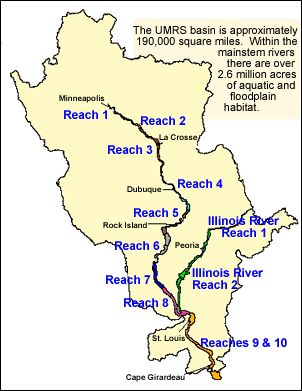
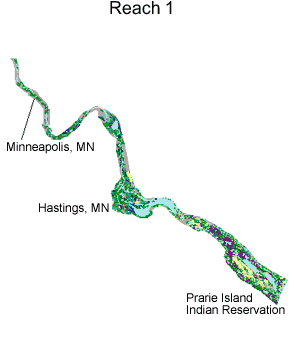
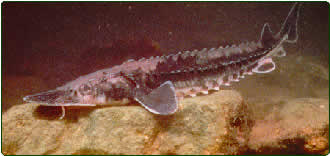
 The
mainstem dams of the UMRS navigation project formed a series of shallow
reservoirs called navigation pools. The pool scale is important in assessing
the physical environment that defines habitat for species that display
seasonal movements of about 20 miles or less. UMRS navigation pools differ
in their mix of habitats among river reaches. Wide-ranging residents within
navigation pools include a variety of fishes such as largemouth bass,
northern pike, catfish, and buffalo which make seasonal movements to find
appropriate habitats to spawn, feed, or over-winter. Some species require
flooded vegetation to spawn, others need structure and undercut banks,
and some require firm bottom substrate. Most fish species require winter
habitat with low current, adequate levels of dissolved oxygen, and water
temperatures higher than freezing. All seasonal habitat needs for resident
species
The
mainstem dams of the UMRS navigation project formed a series of shallow
reservoirs called navigation pools. The pool scale is important in assessing
the physical environment that defines habitat for species that display
seasonal movements of about 20 miles or less. UMRS navigation pools differ
in their mix of habitats among river reaches. Wide-ranging residents within
navigation pools include a variety of fishes such as largemouth bass,
northern pike, catfish, and buffalo which make seasonal movements to find
appropriate habitats to spawn, feed, or over-winter. Some species require
flooded vegetation to spawn, others need structure and undercut banks,
and some require firm bottom substrate. Most fish species require winter
habitat with low current, adequate levels of dissolved oxygen, and water
temperatures higher than freezing. All seasonal habitat needs for resident
species  must
be met within a navigation pool because dams restrict access to other
navigation pools. Resident birds maintain home ranges over many square
miles. Cardinals, blue jays, woodpeckers, crows, and many others may use
both floodplain and upland habitats. Some bird species may nest in one
floodplain habitat and feed in another which requires that important habitats
are available within their home range.
must
be met within a navigation pool because dams restrict access to other
navigation pools. Resident birds maintain home ranges over many square
miles. Cardinals, blue jays, woodpeckers, crows, and many others may use
both floodplain and upland habitats. Some bird species may nest in one
floodplain habitat and feed in another which requires that important habitats
are available within their home range. 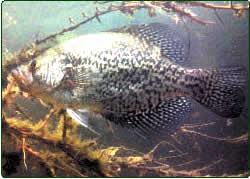
 habitats are available and of suitable quality to support local populations.
Aquatic invertebrates are generally restricted to small areas, but may
drift in currents or migrate during adult aerial stages. Freshwater mussels
are a particularly threatened group of animals that have suffered greatly
through harvest or pollution due to their lack of mobility. Many panfish
and minnows and most small mammals have limited ranges.
habitats are available and of suitable quality to support local populations.
Aquatic invertebrates are generally restricted to small areas, but may
drift in currents or migrate during adult aerial stages. Freshwater mussels
are a particularly threatened group of animals that have suffered greatly
through harvest or pollution due to their lack of mobility. Many panfish
and minnows and most small mammals have limited ranges.